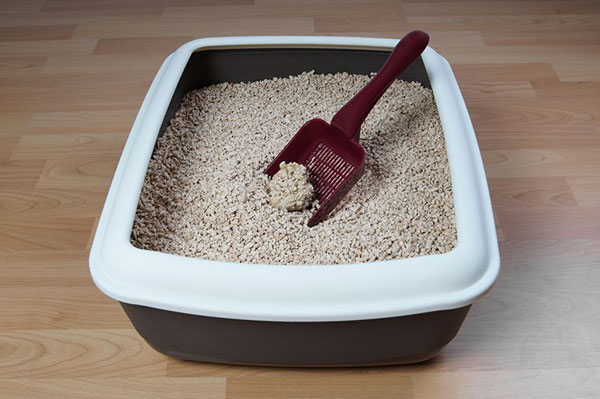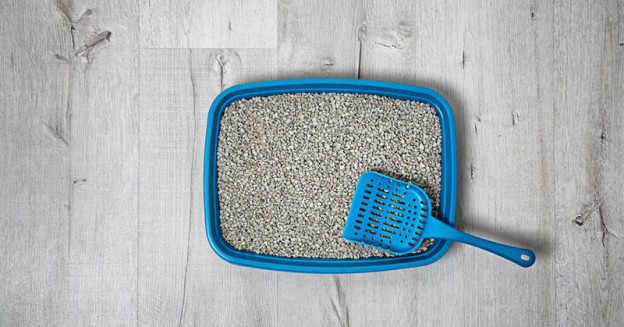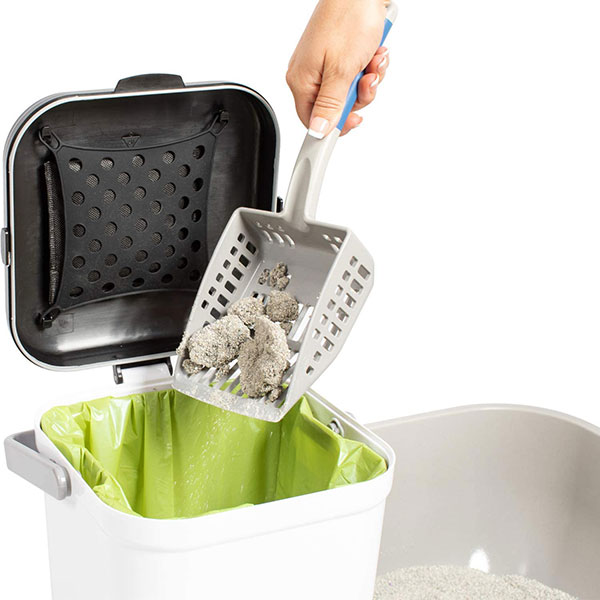Last updated: July 26th, 2023
Cat litter disposal is one of the not-so-pleasant aspects of owning a cat, but it’s an important one. Not only is cat waste messy and smelly, it can cause health issues too so finding the best way to dispose of cat litter is important for your own health, and also the environment.
Here we look at the best ways to dispose of cat litter, and also how not to get rid of it.
It’s important to dispose of cat litter hygienically, and also in the most environmentally friendly way. The main issue is due to microscopic parasite called Toxoplasma Gondii, and it can cause serious health issues for some people. This parasite can be carried in cat poo, and is easily spread if you don’t dispose of the waste correctly.
The Best Ways to Dispose of Cat Litter
1. Scoop and Bin
For most of us, this is the easiest and best option to get rid of your cat’s waste. This is also the advice from the Environment Agency. Scoop the waste, and used litter into a biodegradable poop bag, and put in to your normal household waste bin. When you change the litter in the box, you can empty it into newspaper, wrap it up and bin that.
A more eco-friendly and nose-friendly option is to put the waste directly into a cat litter bin. These enable you to use just one bag for several weeks worth of waste, which cuts down on the number of bags you need to use. The bins have additional sealing and filters to prevent the smell from escaping, so are a great idea if you are concerned about cat waste in your normal bin causing unpleasant odours.
2. Safely Compost Cat Litter
If you use biodegradable cat litter, then another option is to put the used litter onto a compost bin. If you’re using clay litter, then this isn’t an option as clay doesn’t break down. However litter made from materials like pine, paper or corn can be composted.
Composting cat litter is not without risk though, as it can be bad for the environment and risk human health.
If you are intending to use the compost to grow anything edible, or where children might play then do not add any cat litter to your compost heap. Compost made from cat litter should only be used for non-edible plants like roses or perennials.
Also, you should only add the used litter to the compost – always remove the cat poo as the heat generated by the composting process is usually not high enough to kill off the parasites in the poo that cause health issues. The poo should be disposed of as above, by putting into a biodegradable bag and then into your rubbish bin.
To be extra-safe, you’ll also want to leave any compost with used cat litter in it to compost for a long time – 18 months plus. You should also use a compost bin, rather than directly on the ground to avoid any harmful bacteria from contaminating the ground underneath.
Another option is a wormery composter designed for pet waste – although the same advice applies – don’t put cat poo in there, and avoid using the compost on vegetable patches or where children might play.

Always safely dispose of cat litter
Cat Litter Safety Precautions
To avoid any risk of picking up any diseases from handling your cat’s waste, then you can follow these simple tips.
Wear Gloves
Using disposable gloves when emptying your cat’s litter tray will protect your hands, and prevent anything nasty from coming in contact with your skin. This isn’t really necessary for most of us, but a useful precaution if you are a pregnant woman, or suffering from health issues that weaken your immune system.
Use a Mask
Cat litter can create dust when you scoop it up, which can be inhaled and cause breathing difficulties or lung irritations especially for people with conditions such as asthma. Wearing a mask will prevent you from inhaling any of this dust.
Cleaning
It’s advisable to wash your litter scoop under the tap, adding soap if desired. You can also place the scoop in a dedicated bucket or tray when not in use.
You should also wash your hands too, even if you’ve worn gloves. This will help prevent the spread of any harmful bacteria.
What is the Greenest Way to Dispose of Cat Litter?
It’s important to find the most eco-friendly way to dispose of cat litter and waste, as some methods are better for the environment than others.
As we’ve already mentioned, the recommended way is to scoop and bin, however you can help reduce the environmental impact further in two ways
Biodegradable Cat Litter
Use a kitty litter made from natural materials that will more easily break down. Most biodegradable cat litters are made from ingredients such as wood, corn, recycled paper and grass seed.
Avoid litters made from clay (sodium bentonite), or that contain artificial fragrances. Clay litter is bad because not only does it cause environment damage when it is extracted, but it also doesn’t break down.
You can find out more about what types of cat litter are available in our review of the best cat litter.
Biodegradable Poo Bags
If possible, always dispose of your cat’s waste in a biodegradable bag, and use old newspaper to get rid of old litter when cleaning the tray. However not all biodegradable bags break down as quickly and easily as others so it’s worth doing a bit of research to double-check before buying.
If something is “biodegradable”, it means it can break down naturally. Bags described as “compostable” means they will break down if sent to a proper compost facility, and may not necessarily mean that it will break down in your garden compost heap.
Look for bags marked with the code EN13432 – this is an EU standard that certifies a material will disintegrate after 12 weeks and completely biodegrade after six months.
How Not to Dispose of Cat Waste
Some people recommend burying cat poo in a hole in your garden, however this is not a good idea generally as if the poo contains any parasites, they may end up seeping into the water supply. This is especially so if you live near the coast, or a river.
You should also not flush cat waste or litter down the toilet – you can read more about why this is a bad idea here – why you shouldn’t flush cat litter down the toilet.





